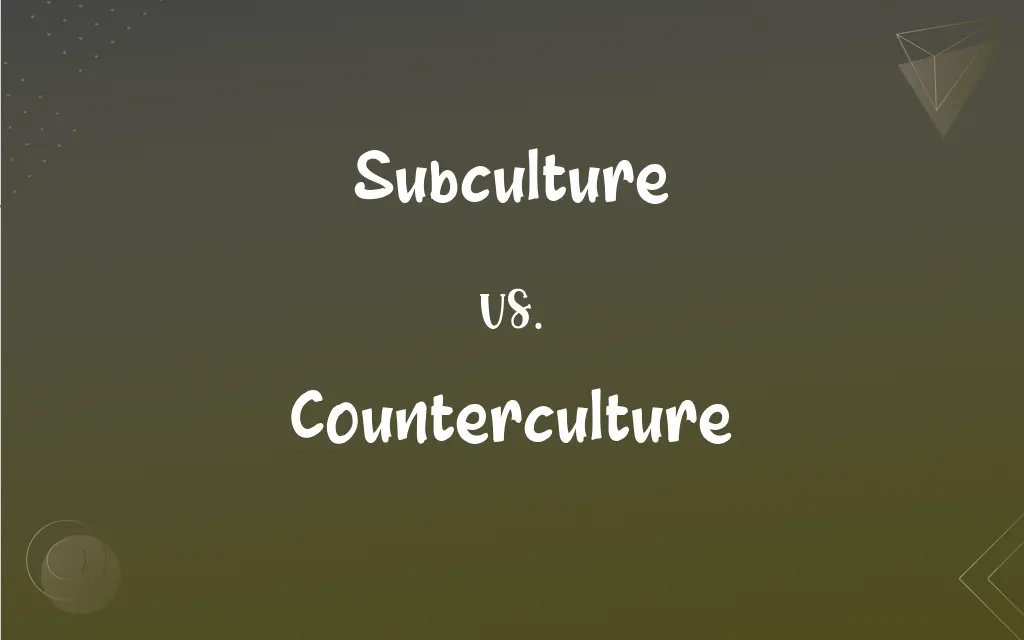Subculture vs. Counterculture: What's the Difference?
Edited by Janet White || By Harlon Moss || Updated on October 20, 2023
A subculture is a group within a larger culture with distinct values and beliefs; counterculture opposes mainstream cultural values.

Key Differences
A subculture refers to a cultural group within a larger culture, sharing distinct values, beliefs, and practices. These practices don't necessarily go against mainstream culture but may simply be unique or specialized. Counterculture, conversely, describes a group that actively opposes and rejects some of the broader culture's norms and values.
While both subculture and counterculture exist within a larger cultural framework, their relationship with the mainstream culture varies. Subcultures coexist with the dominant culture, adding diversity and richness without necessarily challenging its core values. Countercultures, on the other hand, arise as reactions against the dominant culture, often advocating for change and presenting alternative values and beliefs.
For example, the punk rock movement can be seen as both a subculture and a counterculture. As a subculture, it embodies a unique style of music, fashion, and ethos. However, as a counterculture, it critiques and resists certain societal norms, championing non-conformity and rebellion.
Another distinction lies in acceptance. Subcultures are generally seen as harmless or merely different, gaining acceptance or at least tolerance from the larger culture. Countercultures, being more confrontational, can be viewed with suspicion or outright hostility by mainstream society, due to their challenge to the established order.
Comparison Chart
Definition
A group within a larger culture with distinct values.
A group that opposes mainstream cultural values.
ADVERTISEMENT
Relationship
Coexists with mainstream culture.
Opposes and challenges mainstream culture.
Origin
Arises from shared interests or traits.
Arises as a reaction to dominant cultural norms.
Acceptance
Generally tolerated or accepted.
Often viewed with suspicion or hostility.
Purpose
Adds diversity to the larger culture.
Seeks to change or critique societal norms.
Subculture and Counterculture Definitions
Subculture
A cultural faction within a larger cultural body.
The hip-hop subculture has significantly influenced mainstream music.
ADVERTISEMENT
Counterculture
A group challenging dominant cultural norms.
Punk rock emerged as a counterculture challenging societal conformity.
Subculture
A segment of society sharing distinct norms and values.
Skateboarders have created a subculture with its own style and lingo.
Counterculture
A reaction against established societal values.
The Beat Generation was a counterculture questioning post-war norms.
Subculture
A subset within a broader societal context.
Veganism is a subculture promoting plant-based lifestyles.
Counterculture
A cultural group advocating for alternative lifestyles.
The free love movement was a counterculture promoting non-traditional relationships.
Subculture
A group characterized by shared interests or traits.
The gaming community is a thriving subculture.
Counterculture
A movement opposing mainstream societal values.
The hippie movement was a counterculture of the 1960s.
Subculture
A group with specialized practices within a larger society.
The Amish community is a religious subculture in the U.S.
Counterculture
A societal segment resisting mainstream ideologies.
The anti-establishment protests of the 1970s epitomized counterculture sentiments.
Subculture
A cultural subgroup differentiated by status, ethnic background, residence, religion, or other factors that functionally unify the group and act collectively on each member.
Counterculture
A culture, especially of young people, with values or lifestyles in opposition to those of the established culture.
Counterculture
Any culture whose values and lifestyles are opposed to those of the established mainstream culture, especially to western culture.
Counterculture
A culture with lifestyles and values opposed to those of the established culture
FAQs
How does a subculture develop?
Subcultures often develop from shared experiences, interests, or challenges that set them apart from the dominant culture.
Can a person belong to multiple subcultures?
Yes, individuals can identify with or participate in multiple subcultures.
Give an example of a subculture.
Skateboarding enthusiasts form a subculture with unique fashion, language, and practices.
Are subcultures always small in size?
No, they can vary in size and influence, from small groups to larger segments of society.
How do subcultures influence mainstream culture?
They can introduce new ideas, fashions, music, and perspectives that may eventually become part of the broader culture.
Are all subcultures positive?
Like any culture, subcultures can have positive, neutral, or negative impacts on individuals and society.
Can subcultures fade or evolve?
Yes, as societal conditions change, subcultures can adapt, merge, or diminish.
Give an example of a counterculture.
The hippie movement of the 1960s that opposed consumerism and supported peace and love.
Are countercultures always radical?
They often challenge mainstream views, but the degree of their radicalism can vary.
How do countercultures start?
They often arise in response to societal changes, injustices, or perceived shortcomings in the dominant culture.
What is a subculture?
A subculture is a group within a larger culture that has its own distinct values, beliefs, and practices.
How are subcultures studied?
Through methods like ethnography, sociological analysis, and cultural studies, among others.
What is a counterculture?
A counterculture opposes or rejects the norms and values of the mainstream culture.
Do countercultures exist globally?
Yes, wherever dominant cultures exist, there are often countercultures challenging their norms.
Is every subgroup a subculture?
Not necessarily. A subculture has distinct values and practices, whereas not every subgroup does.
Can countercultures become mainstream?
Over time, some countercultural ideas or practices can be adopted by the wider society.
How are countercultures perceived?
Often viewed with suspicion or hostility by the mainstream, but can also be seen as catalysts for change.
Can countercultures have subcultures within them?
Yes, even within countercultures, distinct subgroups with their own norms can emerge.
Are countercultures always associated with youth?
While often linked to youth movements, countercultures can involve people of all ages.
How is counterculture different from subculture?
While subcultures may coexist with the dominant culture, countercultures actively resist or challenge it.
About Author
Written by
Harlon MossHarlon is a seasoned quality moderator and accomplished content writer for Difference Wiki. An alumnus of the prestigious University of California, he earned his degree in Computer Science. Leveraging his academic background, Harlon brings a meticulous and informed perspective to his work, ensuring content accuracy and excellence.
Edited by
Janet WhiteJanet White has been an esteemed writer and blogger for Difference Wiki. Holding a Master's degree in Science and Medical Journalism from the prestigious Boston University, she has consistently demonstrated her expertise and passion for her field. When she's not immersed in her work, Janet relishes her time exercising, delving into a good book, and cherishing moments with friends and family.






































































